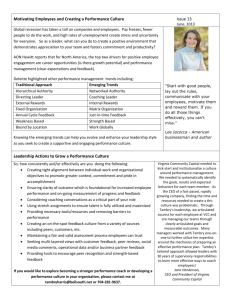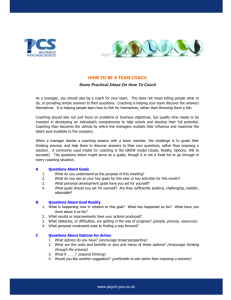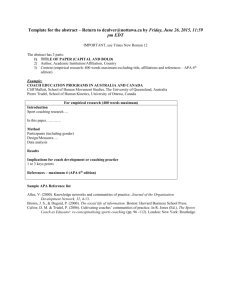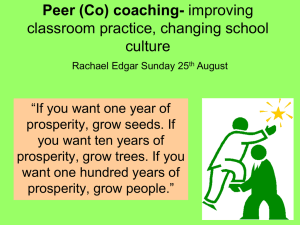The Coach Approach
advertisement
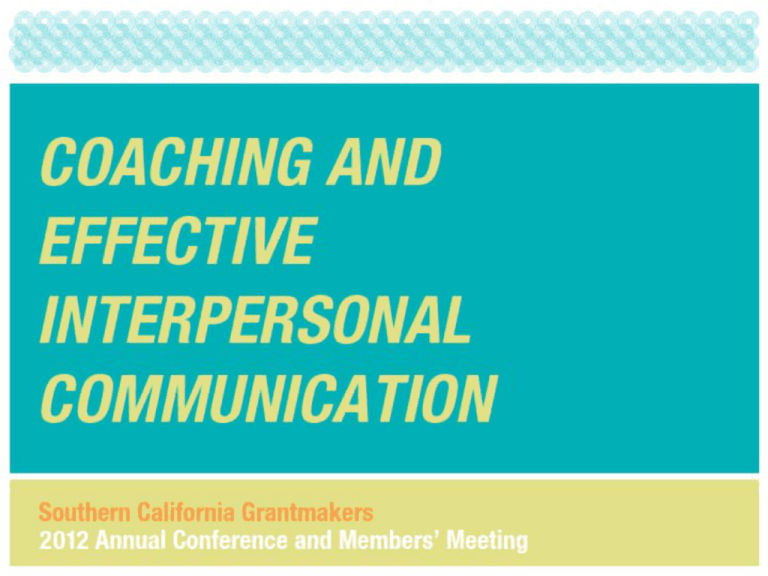
The Coach Approach Presented by: Alicia Santamaría Acorn Or empty vessel? The Coach Approach to Communication Agenda and Objectives What When Key Skills: Listening Inquiry Giving Feedback GROW Model (Introduction) Workshop Agreements Challenge by Choice Each participant has ownership of his or her experience. Growth Zone: Where the greatest learning occurs Simply Defined Facilitative (vs. Instructive) Listen Pull from Inquire Empower Brainstorm Facilitate Creates the space for reflection, discovery, awareness, & choice. Honors people’s own wisdom, experience, and strengths. Practice Turn to a partner. The person with the longest hair will be the coach first. Speaker - talk about your greatest challenge at work for 30 seconds. Coach – tell, show, explain to the person being coached what to do to fix the situation. Give advice. SWITCH Speaker – talk about your greatest challenge at work for 30 seconds. Coach – Only ask questions. Hold your advice back. Facilitate the person being coached to think about what they want to do with their situation. When? Turn to a partner and create a brainstorm list of all the possible situations/relationships where you currently “coach” people or where you could start to use the “coach approach” more intentionally… When is the “coach approach” not appropriate? Skill #1: Listening Modes of Listening What it looks like Superficial Listening I’m listening to you but I am distracted with my own thoughts. I don’t hear you. In this situation, it’s really all about me. Self-referential Listening I’m listening to you, but I will nudge the conversation. So now it becomes all about me. Fix-it Listening I’m listening to you but I want to fix your issue by myself. In this situation, it’s really all about me, in relation to you. Engaged Listening I’m listening to you with full attention. I want to understand better who you are and what this experience is like for you. In this situation, it’s all about you. © 2012. Judith Wilson & Associates, Michelle Gislason of CompassPoint Nonprofit Services. Why am I talking? “Obsession with our own thoughts and opinions and the compulsion to talk, particularly if one is placed in any kind of advisory role, are strong. It has been said that since we were given two ears and one mouth, we should listen twice as much as we speak.” – Coaching for Performance: GROWing Human Potential and Purpose Silent (and Engaged) Listening Turn to a partner, speaker will share something they are working on right now for 1.5 minutes. Listener – says nothing! Engaged but silent. Switch What was that like? How many people started to move forward or solve things themselves? Skill #2: Inquiry Inquiry The ability to ask useful questions to stimulate another person’s thinking and to help elicit from that person new behaviors, actions, goals, or solutions. Curiosity vs. Information Gathering The Difference Information Gathering Curiosity What topics will you include in the report? What will finishing the report mean for you? How much exercise do you need each week? What would “being fit” look like for you? What training options are available? What do you want to know that you don’t know today? Types of Questions Open-ended Closed-ended Why Rewriting Questions Closed-ended Question Do you understand what I’m saying? Open-ended Question Did you ask her about it? Have you tried doing it like this? Is it possible? © 2012. Judith Wilson & Associates, Michelle Gislason of CompassPoint Nonprofit Services. Presented with permission of the authors. Do not copy. Do not transfer. Skill #3: Giving Feedback 2 Types of Feedback Appreciative What is Appreciative Feedback? What is its purpose? How is it done? Developmental What is Developmental Feedback? What is its purpose? How is it done? © 2012. Judith Wilson & Associates, Michelle Gislason of CompassPoint Nonprofit Services. Presented with permission of the authors. Do not copy. Do not transfer. Appreciative Feedback Example: You really kept us on track during the meeting and provided a calming presence when the conversation got heated. Thank you. Practice: Write down an appreciative feedback statement you would like to give someone. Now get up, walk around, and “blurt” your statement to 3 people. Notice what is happening in the room. Developmental Feedback Example: I would like to talk about the grant report deadlines and how we can work together to ensure they are met. Practice: Write down a developmental feedback message you need to give to someone. Share it with a partner. Ask that partner how that landed and discuss any changes you might want to make. GROW Coaching Model GROW Outline: What do you want? Goal What is happening? Reality What could you do? Options What will you do? Will The Journey First you start with a map: With this you help the person decide where they are going (their Goal)… …and establish where they currently are (their Current Reality). Once reality is clear, goals might need to be brought into sharper focus, or even altered if the situation turns out to be a little different from what was previously thought. Then you explore various ways (the Options) of making the journey. Always check back to make sure the options move you towards the goal. In the final step, establishing the Will, you ensure your team member is committed to making the journey and is prepared for the conditions and obstacles they may meet on their way. Change and Transition How can you use the “Coach Approach” to help people dealing with change and transition? “Coaching is not merely a technique to be wheeled out and rigidly applied to certain prescribed circumstances. It is a way of managing, a way of treating people, a way of thinking, a way of being. Roll on the day when the word coaching disappears from our lexicon altogether and it just becomes the way we relate to one another at work, and elsewhere too.” From: Coaching for Performance: GROWing Human Potential and Purpose Reflection/Intention: What are you taking away from this workshop that you will use? Bibliography Coaching for Performance: GROWing Human Potential and Purpose (The principles and practice of coaching and leadership); John Whitmore; Nicholas Brealy Publishing, 2009. Coaching Skills For Nonprofit Managers and Leaders: Developing People to Achieve Your Mission, Michelle Gislason and Judith Wilson; Jossey-Bass; 2010. Coaching with the Brain in Mind, David Rock and Linda Page; John Wiley and Sons; 2009. Co-Active Coaching: New Skills for Coaching People Towards Success in Work and Life, Karen Kimsey- House, Henry Kimsey-House, Phillip Sandahl, Laura Whitworth; Davies Black Publishing; 2007. Online Resources Marshall Goldsmith Library http://www.marshallgoldsmithlibrary.com The Coaches Training Institute http://www.thecoaches.com Special Acknowledgment To Judith Wilson, M.C.C, author of the Coaching Skills for Managers and Leaders Training and book for use and adaptation of her materials.




